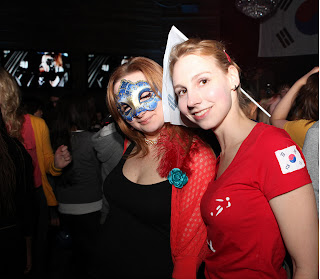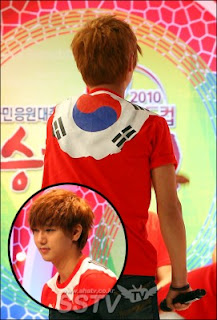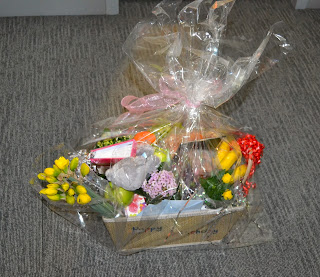Welcome to week 8 of the K-Pop Academy. Is it me, or is time flying?
This week we're doing traditional Korean music. Who else didn't see that one coming? I know I was surprised.
Last week's class
 |
| Learning how to play Samul-nori in class |
Last Saturday our class got a special gayageum performance by Jung Ji-eun, which I really enjoyed. Though it has to be said that I instantly prefered the 25 strings Gayageum to the 12 string one. It sounds more harmonious if you ask me.
After the mini concert professor Keith Howard of the SOAS University of London gave us a brief lecture about traditional Korean music, followed by Ms. Nami Morris' 'Samul nori' workshop, teaching us some traditional Korean rhythms.
Samul-nori
Samul-nori is one of the traditional Korean music genres. The name basically says it all. 'Samul' means 'four objects', 'nori' means 'play'. And that's exactly what it is: four instruments working together.
There are two drums and two gongs.
The first drum is the 'buk', which is very similar to a normal barrel drum and symbolises clouds.
The second drum 'janggu' is an hourglass-shaped drum, which symbolises rain and is the most difficult to play out of them all.
The first gong is 'kkwaenggwari' and it symbolises thunder. This is quite small instrument which makes a similar sound to someone hitting on an old pan with a spoon.
The second gong is called the 'jing' and symbolises wind. This is the instrument I played!
When I say "play" I mean "held up", as me and Alice had to share it and she was the on in charge of the actual hitting (she accidentally hit me at one point, haha). I didn't mind though. I was standing behind the instrument and it sounds a bit strange, but it was so much fun! The amount of airwaves the jing produces when hit is really amazing. It really is like one of those big gongs you see in movies or on television. My intestines are still shaking.
 |
| Alice and I while trying to "play" the jing. |
Though it's clear to see in the picture I have no talent in playing Samul-nori what so ever, this was not down to the fact that it was all new to me. I had seen and heard some music of this genre before when I was in Korea during a show called Nanta.
Nanta
Nanta (internationally known as 'Cookin'', see here for more information) is a popular South Korean musical, which premiered in 1997. It's basically a play with Samul-nori performances, in which they replaced the instruments with cooking utensils, incorporated in it. It might sounds weird when you first hear about it, but it's actually really, really good! If you ever get the chance to go see it you definitely should.
For those unable to see it live I found some videos. The first video will help you get an overall impression of what 'Nanta' is like. The second video gives you contains more insight of the modern take on Samul-nori in this play.
(Click on the title to watch the it in way more superior quality on Youtube)
Funnily enough, towards the end of the Nanta show the artist perform 'samgo-mu', which is a traditional Korean drum dance. Here is a video of it to give you an idea what I'm talking about.
It might look familiar to you. If it does, you probably like 2NE1 and have the eyes of an eagle. It was my friend Amy who told me that Samgo-mu was used in 2NE1's 'I'm The Best' video and didn't believe her at first. But when I watched the video again it was definitely there. Go see for yourself! It starts at around 2:40.
See? Totally random, right? It doesn't have anything to do with the song, but it is very traditionally Korean. Which brings me to this week's homework.
This Week's Assignment
This week I chose for option C: Find three examples where Korean traditional music has been integrated with contemporary music (K-Pop or Western). So, after quite a few hours of research (while Skyping with Amy) I chose the following songs:
1.
I chose this video because it's a nice blend between Korean rhythm and western Jazz. Simon Barker drumming sounds almost exactly like the sound that the janggu makes in Samul-nori and, just like during a jjangu solo, it's easy to get the symbolic meaning of the rain. But the most amazing thing about this solo is: it is an improvisation. It's completely unscripted, wow!
2.
What I like about this group is that they created exactly the right balance between western and traditional korean musical influences. You can recognise both very easily, but neither of them overpowers the other.
3.
Creative Content
Oh la la, this is where it gets really exciting! I'm a big fan of Jun Areia's K-Pop Remixes, so for this week homework thought it would be really nice if I could create my own little soundbite of a mixture between traditional Korean music and modern western music. That would be kinda cool, right?
Now, keeping in ming that I'm not musically gifted in any way, shape, or form, this does not sounds like the best idea I ever had... But let's be fair, how often does real life provide you a legit excuse for pretending to be a DJ/producer? Not too often, so I just had to take this opportunity with both hands.
Turns out, remixing music is even harder than I thought it would be. Luckily for me, after two hours of getting absolutely no where and realizing that I'm completely incompetent when it comes to make music on a computer, my study colleague Will English helped me out of my misery. He is absolutely brilliant at mixing and making music and he made me what I like to call a ringtone based upon 'Arirang'.
For those who don't know 'Arirang', the traditional version goes something like this:
My friend turned the traditional instrumental version this song into a modern, dance song.
I really love this song. So much so that it's currently my ringtone and alarm, haha!
I hope you enjoyed it just as much! ^^
Hope to see you next week!





































